
The media outlets included in this study range from small, volunteer-run news organisations that share content through newsletters, podcasts and messaging apps, to large multi-platform operations with more than 100 journalists, editors and other professional team members.
When we analysed all of the media in this study that reported having full-time staff members, we found the majority had 10 to 19 paid team members.
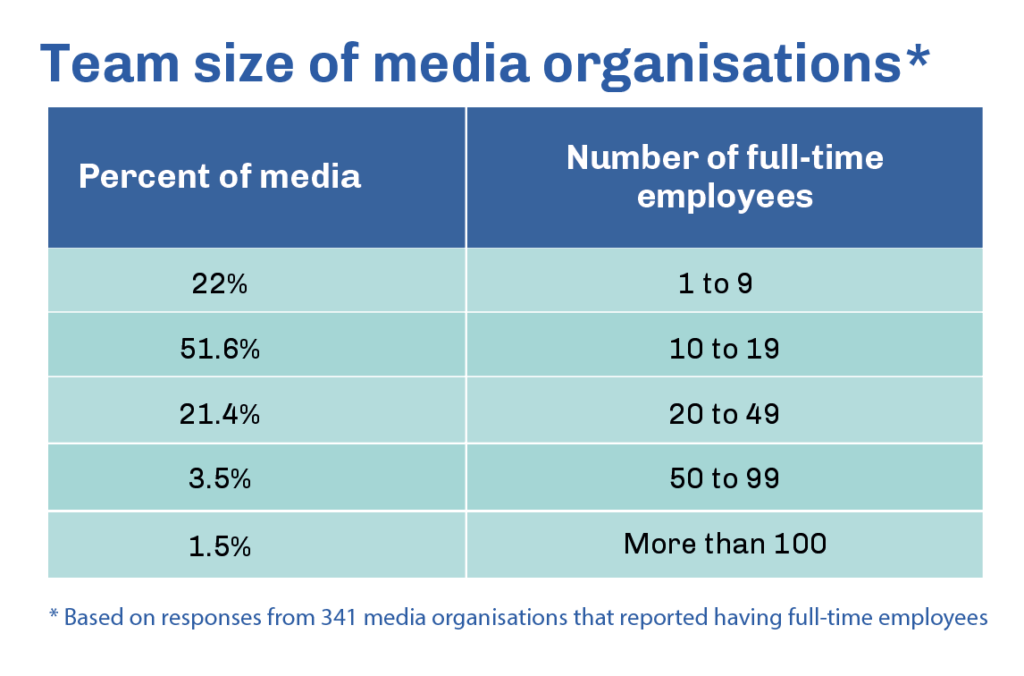
Media with dedicated sales staff report higher revenue
Most of the media outlets in this study were founded by journalists or editors, and they often employ more reporters than business people, but the ones that have invested in expanding their teams to include staff members with skills beyond content production are building more sustainable organisations.
Our findings showed that organisations with at least one employee dedicated to sales or business development reported an average annual revenue six times higher than those that did not employ people in these roles.
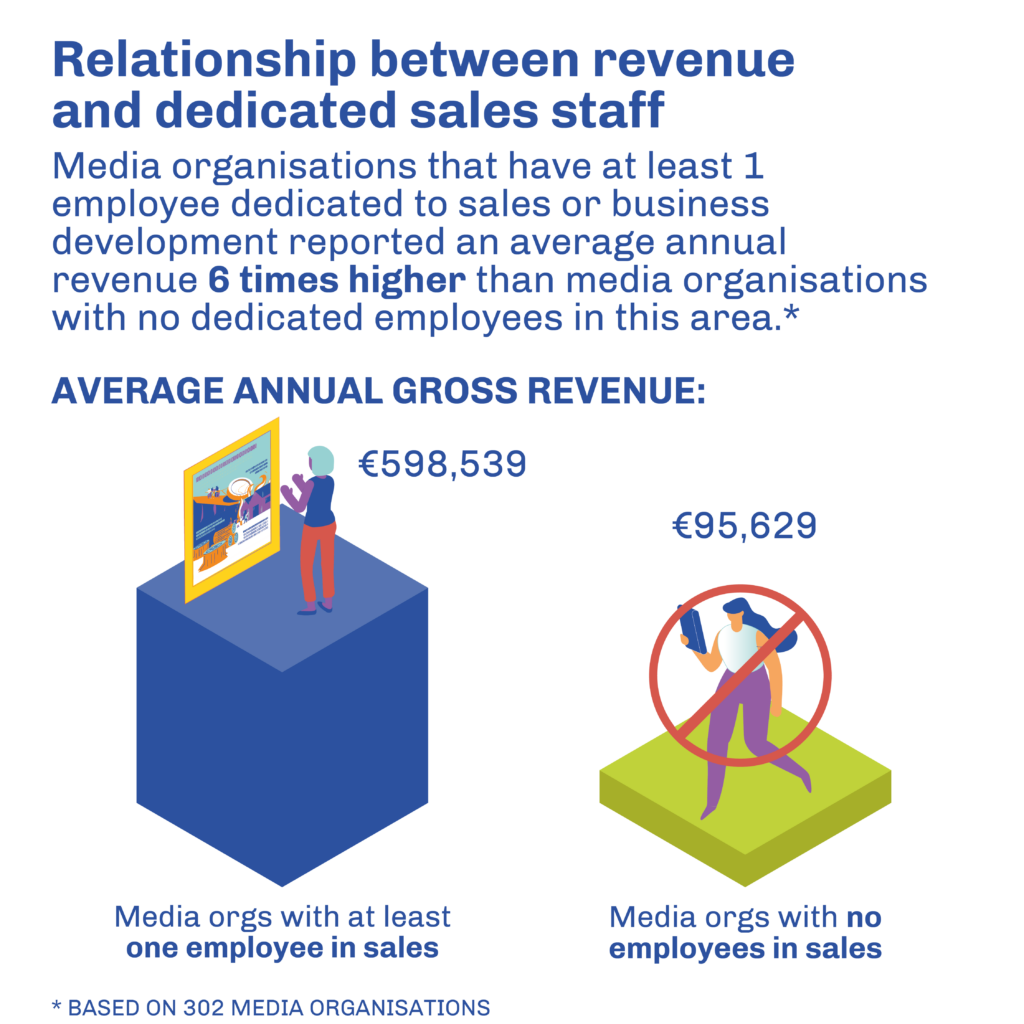
These insights about the value of having dedicated staff members focused on revenue generation are consistent with SembraMedia’s findings from previous research projects, such as our 2021 Inflection Point International report, which included digital native media from Latin America, Africa and Southeast Asia. In that report, media organisations that had a dedicated sales or business development staff member reported annual revenue six to nine times higher than those without dedicated employees working in these areas.
Women media founders breaking the glass ceiling
We found an unprecedented number of women founders among the independent digital native media organisations we studied in Europe.
Looking at all the organisations in our directory, we found that nearly 46% had at least one woman on their founding team. Many outlets included more than one woman among their co-founders.
Delving more deeply, we decided to look at all the media founders in the directory, irrespective of which organisation they came from. We discovered that 58% of them were women — meaning that the majority of all founders in our directory across the board are women.

Finding a high percentage of women founders in these new kinds of media is consistent with our previous research on digital native media in other parts of the world; but in Europe, the numbers are even higher.
In our SembraMedia directory of Hispanic digital native media, 42% of the total number of founders are women.
Note: These figures are based on the number of media included in the Project Oasis and SembraMedia directories in April 2023. Because we continuously update our media directories, these numbers may change over time.
Women-led media tackle serious social issues
The women media founders featured in this study have created news organisations that cover a wide range of topics, from award-winning fact-checking sites, to investigative reporting collaboratives, to sites that focus on underserved communities.
The Czech media outlet Investigace.cz was started by investigative journalist Pavla Holcová because she wanted to do cross-border investigative reporting. When she launched the news site in 2013, it was clear that corruption and crime were happening across borders, but there were no cross-border teams of journalists covering these stories, she said.
Holcová founded Investigace.cz as an Organized Crime and Corruption Reporting Project (OCCRP) partner organisation in the Czech Republic, and by 2022 her newsroom had grown to include 10 members and contributors. The information on the website is partly original investigative stories produced by the outlet’s own team, and partly reports from other OCCRP partners. Investigace.cz also produces a podcast, which covers crime and corruption cases in greater depth.
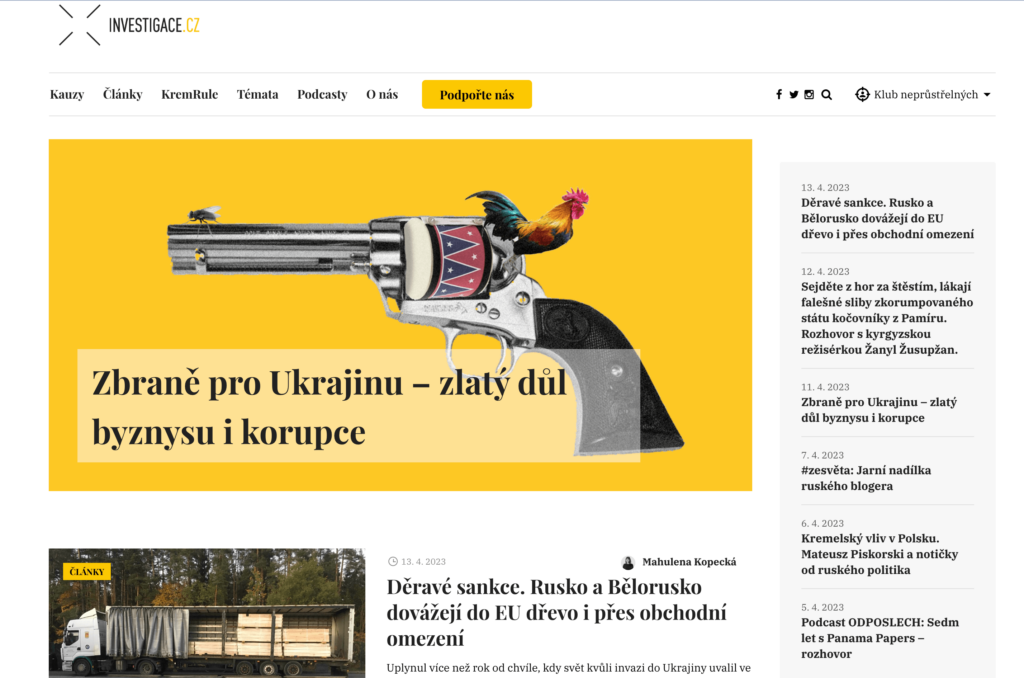
The Andererseits.org news site, which was founded by three women, describes its mission this way: “Although around 15-20% of people living in Austria have a disability, there are only a handful of journalists with disabilities. We change that.”
Katharina Brunner, Katharina Kropshofer and Clara Porák founded the media outlet in 2020. All of the editors worked as volunteers, until a successful crowdfunding campaign in 2022 enabled them to grow, professionalise and start paying their first employees. The team aims to make all aspects of journalistic content production — from text to graphics, research to video production — as inclusive and accessible as possible.
In Italy, media founders that have a background in academia aim to spread their knowledge and expertise outside their field. The publication inGenere, a magazine that covers economics with a gender perspective, strives to give visibility to the opinions of high-profile female academics who are “ignored by mainstream media”, as the outlet’s editor-in-chief, Barbara Leda Kenny, explained.
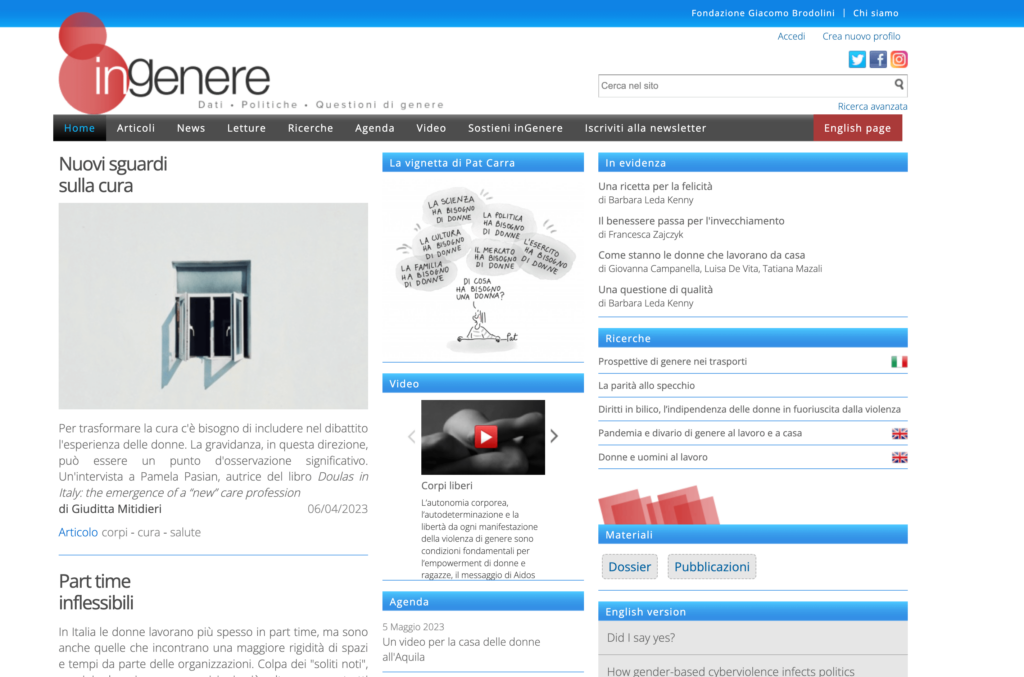
Digital native media with both male and female founders earn more revenue
Another key insight was that media with at least one female and one male founder reported the highest revenues, with an average of €509,740 annual revenue.
Media with only male founders reported the second highest average annual revenue of €497,719 — more than four times that of organisations with only female founders.
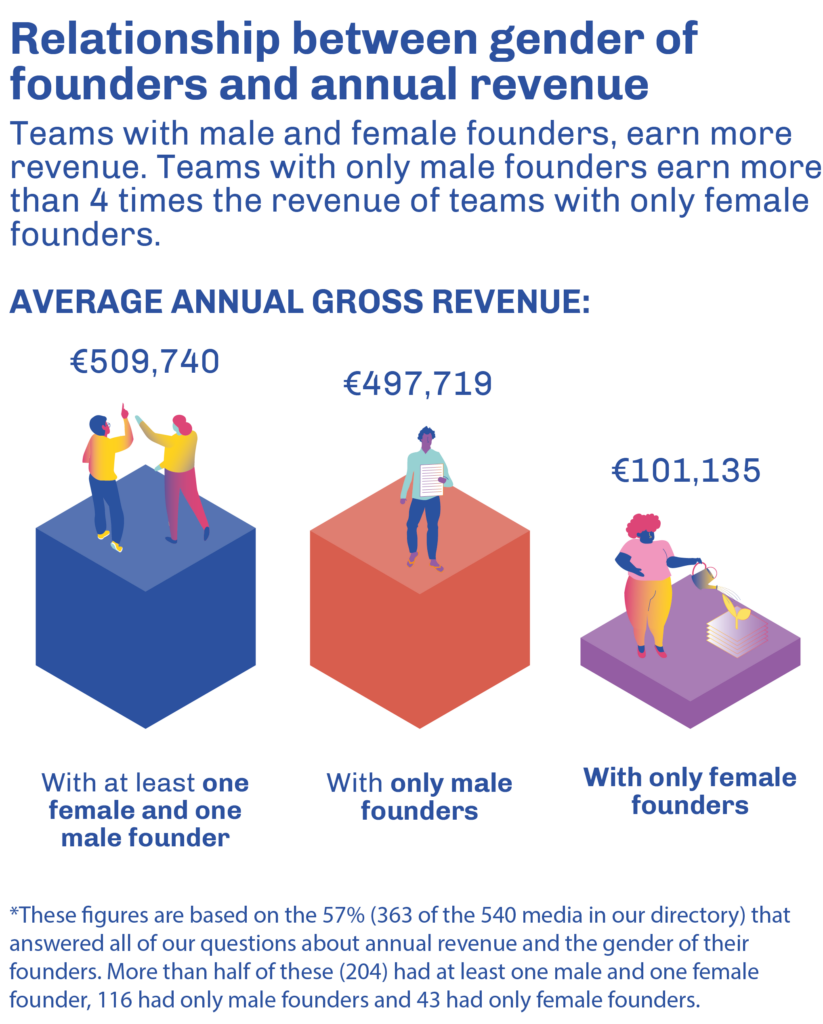
Although there are many reasons for this disparity, anecdotal conversations captured during our interviews suggest some of the causes are:
- A persistent lack of women in investment decision-making roles, which compounds the finance gap (i.e investors typically invest in teams that look like them)
- Evidence of higher risk aversion towards women-led companies
- The limited pool of women-led companies and female entrepreneurs in Europe in general
- The need for policy and funding bodies to provide more equitable support to women-led companies
The report Why are women entrepreneurs missing out on funding provides some insights on how to provide more equitable funding opportunities in Europe. It was written by Surya Fackelmann and Alessandro De Concini for the European Commission in 2019.
Outlets with women founders feature more transparency policies
In contrast with other parts of the world where we have done similar research, Europe seems to put a higher value on the use of transparency policies published on news sites. This is likely due, at least in part, to the implementation of the General Data Protection Regulation (GDPR) across EU member states in 2018.
To better understand how independent digital native media were following this trend, we asked nine questions in our interviews about transparency.
All interviewees were asked the same nine questions about transparency policies, including whether the media outlet publishes policies regarding data privacy, complaints and sexual harassment. We also asked whether they publish information about annual revenues and the names of donors, as well as the names of founders and team members.
The media organisations that reported having the most extensive and thorough transparency policies also had at least one woman founder. Delving deeper into the data, we found that 86% of the media that were founded only by women answered “yes” to all nine transparency questions. By comparison, only 62% of the media with only male founders answered “yes” to all of our transparency questions.
The relationship between transparency and annual revenue
The more transparent the media, the more they seem to be respected by donors. We found that organisations that commit to crafting the most extensive transparency policies, especially when those policies are published on that outlet’s website, are more likely to receive grants and individual donations.
The media with the most transparency policies reported an average annual revenue of €691,234, which is higher than the general average. The primary revenue source for these organisations was grants, followed by individual donations.
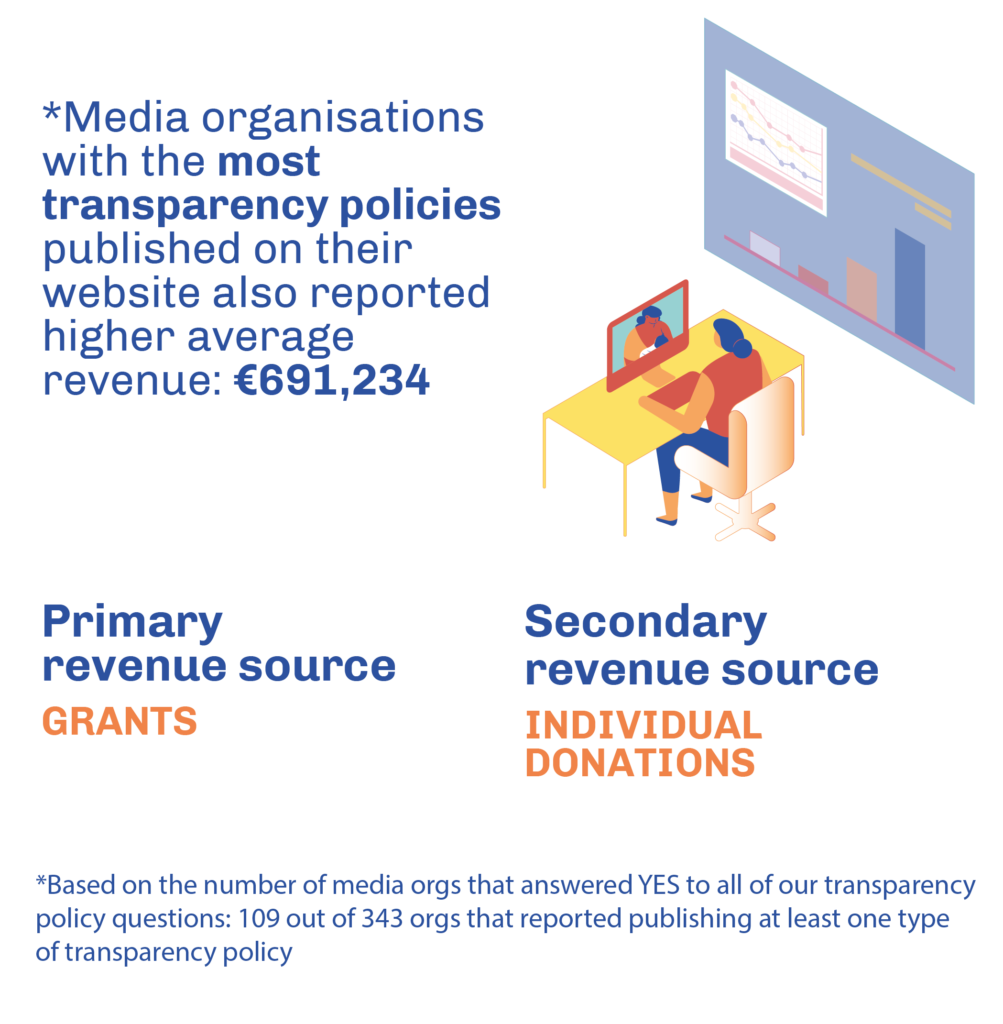
Of the 343 media organisations that said they publish at least one transparency policy, 32% said they had implemented all nine of the policies we included in our questionnaire.
(You’ll find our questions related to transparency in the PDF included at the end of the About the Study section, where we published our entire questionnaire — as part of our own effort to be transparent.)